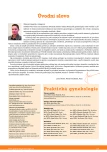Elective single embryo transfer
Authors:
M. Poláková
Authors‘ workplace:
GEST IVF, Centrum reprodukční medicíny
; Nad Buďánkami II/24, 150 00 Praha
5
Published in:
Prakt Gyn 2010; 14(3): 128-132
Category:
Review Article
Overview
Aim:
Sterility treatment, through assisted reproductive techniques, has brought about an unprecedented increase in multiple pregnancies (MP) worldwide. Are we able, by transferring one embryo only under clearly defined conditions, to significantly affect this adverse trend without a negative impact on results of assisted reproduction? Is it possible to apply elective single embryo transfer (eSET) in all IVF centres?
Methods:
The present review paper analyzes current situation in eSET application in the Czech Republic and worldwide.
Results:
Success of eSET programmes can be judged by comparing cumulative pregnancy rates (PR) after eSET and frozen-thawed embryo (FET), with double embryo transfer (DET) PR. Although there are great differences among studies, it is possible to say that there is always at least a mild decrease in PR in eSET+FET groups in comparison to DET (difference 4–11%). However, PR in eSET+FET group is, in these studies, rather high – a minimum of 38% – and a decrease in twin pregnancies is significant.
Conclusion:
The decision to apply eSET must be weighed by each IVF centre on the basis of its own actual results. Only the IVF laboratories with good long-term results have the capacity for twin pregnancy reduction through eSET. The conclusion we draw depends on our priorities. We can offer a mild decrease of PR for considerable reduction of twin pregnancies. From an economic point of view, when satisfactory PR is established in an eSET+FET programme, short-term costs caused by higher numbers of embryo transfers are outweighed by lower long-term care costs for new-born babies. On the basis of these economic advantages, the state and insurance companies should encourage IVF centres and patients to apply the eSET programmes, when appropriate.
Key words:
IVF/ICSI – multiple pregnancies – embryo selection – single embryo transfer
Sources
1. Nygren KG, Andersen AN. Assisted reproductive technology in Europe,1999. Results generated from European registers be ESHRE. Hum Reprod 2002; 17(12): 3260–3274.
2. Andersen AN, Goosens V, Ferraretti AP et al. Assisted reproductive technology in Europe, 2004, results generated from European registers by ESHRE. Hum Reprod 2008; 23(4): 756–771.
3. Český statistický úřad http://www.czso.cz/. Porodnost a plodnost – vícečetné porody. 4008–06.
4. Hájek Z et al. Transfer embrya, počet transferovaných embryí. Vícečetná a jednočetná gravidita. Rizikové a patologické těhotenství. GRADA Publishing, Drbohlav P., 2004; Kap. 20.1.4 : 236–237.
5. Gregor V, Šípek A, Horáček J et al. Analýza incidencí vrozených vad v České republice podle četnosti těhotenství. Čes Gynek 2008; 73(4): 199–208.
6. Mouzon J, Goosses V, Bhattacharya S et al. Assisted reproductive technology in Europe, 2006: results generated from European registers by ESHRE. Hum Reprod 2010; 25(8): 1851–1862.
7. Gardner DK, Weissman A, Howles CM. Evaluation of embryo quality: new strategies to facilitate single embryo transfer. Textbook of assisted reproductive technologies. Informa Healthcare, London, Sakkas Denny, 2009 : 241–251.
8. Baart EB, Martini E, Eijkemans MJ et al. Milder ovarian stimulation for in-vitro fertilization reduces aneuploidy in the human preimplantation embryo: a randomized controlled trial. Hum Reprod 2007: (22): 980–988.
9. Staessen C, Verpoest W, Donodo P et al. Preimplantation genetic screening does not improve delivery rate in women under the age of 36 following single-embryo transfer. Hum Reprod 2008; 23(12): 2818–2825.
10. Gerris JMR. Single embryo transfer and IVF/ICSI outcome: a balanced appraisal. Hum Reprod Update 2005; 11(2): 105–121.
11. Thurin A, Hausken J, Hillensjo H et al. Elective single embryo transfer in IVF, a randomized study. Hum Reprod 2004; 19 (supppl 1): i60.
12. Koryntová D, Moosová M, Řežábek K et al. Transfer jednoho embrya u pacientek s dobrou prognosou léčby pomocí IVF/ICSI nesnižuje pravděpodobnost otěhotnění. Čes Gynek 2005; 70(6): 435–439.
13. Fiddelers AAA, Severens JL, Dirksen CD et al. Economic evaluations of single – versus double – embryo transfer. Hum Reprod Update 2007; 13(1): 5–13.
14. Oku H, Tsukuda E, Akamatsu Y et al. Double blastocyst transfer may interrupt implantation. Abstract of the 25th Annual Meeting of ESHRE, Amsterdam 2009: P-372.
15. De Sutter P, Van der Elst J, Coetsier T et al Single embryo transfer, multiple pregnancy rate reduction after IVF/ICSI: a 5-year appraisal. Reprod Biomed Online 2003; 18 : 464–469.
16. Kjellberg AT, Carlsson P, Bergh C. Randomized single versus double embryo transfer: obstetric and paediatric outcome and cost-effectiveness analysis. Human Reprod 2006; 21(1): 210–216.
17. Thurin Kjellberg A, Olivius C, Bergh C. Cumulative live births rates after single and double embryo transfer: folow-up from the Scandinavian randomised controlled trial. Abstract of the 25th Annual Meeting of ESHRE, Amsterdam, 2009: O-189.
18. Harrild H, Bergh C, Davies M. Clinical efectivness of elective single versus double embryotransfer: results from an individual patient data meta-analysis of randomised trials. Abstracts of the 25th Annual Meeting of ESHRE, Amsterdam, 2009: O-190.
19. Stillman RJ, Richter KS, Banks NK et al Elective single embryo transfer: A 6-year progressive implementation of 784 single blastocyst transfers and the influence of payment method on the patient choice. Fertil Steril 2009; 92(6): 1895–1906.
20. Hojgaard A, Ottosen LD, Kesmodel U et al. Patient attitudes towards twin pregnanties and single embryo transfer – a questionnaire study. Hum Reprod 2007; 22(10): 2673–2678.
21. Van Peperstraten AM, Hermens RP, Nelen WL et al. Perceived barriers to elective single embryo transfer among IVF professional: a national survey. Hum Reprod 2008; 23(12): 2718–2723.
22. Mardešič T. Vícečetná těhotenství a asistovaná reprodukce: Medicínské, psychologické, sociální a finanční aspekty. Moderní gynekologie a porodnictví 2000; 9(3): Suppl.
23. Mardešič T. Transfer jednoho embrya. Komen-tář. Gynekologie po promoci 2004; 4(5): 51–53.
Labels
Paediatric gynaecology Gynaecology and obstetrics Reproduction medicineArticle was published in
Practical Gynecology

2010 Issue 3
Most read in this issue
- Borderline ovarian tumours
- Monozygotic twins in assisted reproduction treatment
- Elective single embryo transfer
- Cardiovascular disease in Turner syndrome, cardiovascular risks associated with pregnancy
